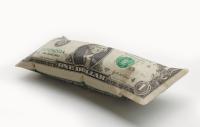Getting Ahead of Inflation
Posted by Nathan Beauvais, CFP®, EA on Fri, 02/12/2021 - 17:05
Have you ever heard someone use the phrase "getting ahead" when talking about their finances? Getting ahead of what exactly? The answer is inflation.
Assessing Risk Levels
Posted by Nathan Beauvais, CFP®, EA on Thu, 02/04/2021 - 10:55
All investments carry risk. This concept is widely understood by the public, however, determining how much risk a particular investment carries is much more complicated.
What Is Money?
Posted by Nathan Beauvais, CFP®, EA on Thu, 01/28/2021 - 10:49
What is money? This may seem like a silly question, but I assure you it is not. Understanding what money is and how it functions in our economy is vital to financial wellness.
A Bizarre Year in Review
Posted by Nathan Beauvais, CFP®, EA on Wed, 12/30/2020 - 16:51
Many will look back on 2020 as a year of unimaginable loss. Investors, however, may have a different take. With the markets fully rebounding to pre-pandemic levels after just five months, the disparity between the fortunes of Wallstreet vs. Main St has left many scratching their heads.
Value v. Growth
Posted by Nathan Beauvais, CFP® on Fri, 10/23/2020 - 15:32
In an environment where it seems that growth investing has gotten all of the attention, value stocks rarely get the spotlight. In this blog post we explore the definition of a value stock and why current trends seem to indicate that you probably shouldn't sleep on them.
The Benefit of Liquidity Risk
Posted by Nathan Beauvais, CFP® on Thu, 09/24/2020 - 10:27
If it takes you a considerable amount of time to sell an asset (think real estate), it likely possesses a high degree of liquidity risk. However, having to jump through hoops to sell a long term investment isn't necessarily a bad thing; especially in a bear market.
Bear Markets: 1973
Posted by Nathan Beauvais, CFP® on Fri, 07/24/2020 - 11:26
The bear market of 1973 was, at the time, the worst stock market crash since the Great Depression. The country was in disarray abroad with Vietnam and domestically with the Watergate scandal. Compound that with an energy crisis and soaring inflation and you can easily see why investors got spooked into making some bad decisions.
Bear Markets: 1980
Posted by Nathan Beauvais, CFP® on Wed, 06/24/2020 - 16:22
The bear market of 1980 is the classic example of a "V-shaped" recovery. It also occurred during one of the most severe recessions in American history, with the unemployment rate peaking at 10.8%.
Bear Markets: 1987
Posted by Nathan Beauvais, CFP® on Wed, 05/27/2020 - 10:19
On Monday, October 19, 1987 the Dow Jones Industrial Average fell 22.6%. To this day, "Black Monday" remains the largest single day drop in the history of the American stock market.
Bear Markets: 1990
Posted by Nathan Beauvais, CFP® on Thu, 05/07/2020 - 11:34
A bear market is defined by a 20% drop from a previous high. During the third and fourth quarters of 1990 the S&P 500 fell 19.9%. While this bear market may have been the smallest in history, it doesn't necessarily mean it was the least scary. Fear is a much harder metric to measure.
